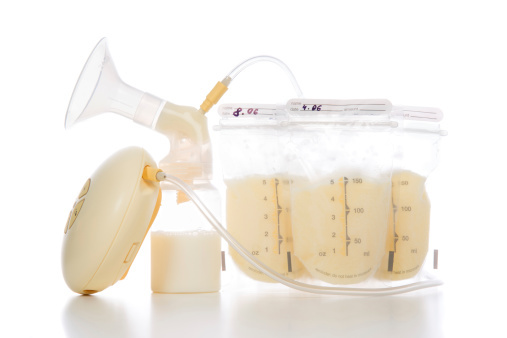Choosing a Breast Pump: What You Need to Know
Crib bedding. Jogging stroller. Baby clothing. Breast pump? Parents-to-be have many purchasing decisions ahead of them. For many, a breast pump is not only one of the most important, but also one of the most foreign: how do you know which breast pump to buy? After all, if you’re a first-time mom, the odds are high you’ve never before even given these devices a second thought. Luckily, we’re here to help. Let’s take a closer look at the world of breast pumps, along with what you need to know to make an informed decision when choosing one.

Types of Breast Pumps
All breast pumps are not created equally. In fact, there are many different types and models, all of which offer different pros and cons. Breast pumps can be broken down into two main categories: manual and electric. Your decision on the type to buy will largely rely upon how often you plan to use it.
Evaluating Your Your Needs
Manual breast pumps, which are smaller and cost significantly less than electric alternatives, are ideally suited for moms with a well-established supply who only plan to pump occasionally. This basic device involves placing a conical shield over the breast and squeezing to express the milk. Manual breast pumps are typically more lightweight and quieter than electric alternatives, but can also take considerably longer and lead to aching hands from the repetitive motion.

If you’re attempting to increase your supply or are a working mom with frequent plans to pump, an electric pump may be a more practical option — particularly when time is at a premium. Electric breast pumps are similar in function, however the work is done for you through an automated suction mechanism.
Because electric breast pumps allow you to express milk from both breasts at the same time, you can reduce pumping time by at least half, and that’s without factoring in the increased efficiency of the electric pump. Considering that the average pumping session takes between 10 and 15 minutes per breast, the electric pump can save you a significant amount of time over the course of days and weeks. Some electric pumps also come with adjustable suction which can be customized to mimic a baby’s suck, both in terms of pace and strength.
Evaluating the Cost
Many couples experience sticker shock when they first learn how much electric breast pumps cost. Before eliminating this type as a possibility, check into whether your insurance plan covers the purchase.
Additionally, consider renting an electric breast pump from your hospital or local medical supply store. Many rent hospital-grade models at reasonable prices. (Rentals may also be covered by insurance.) If you do rent a breast pump, you will need to buy a pumping kit. Consisting of the tubing, shields and other equipment that attaches directly from the pump to your breast, this eliminates the potential risk of contamination.
According to La Leche League, buying or borrowing a used pump — aside from hospital-grade models — is not advised because they are “open systems,” in which milk can be aspirated back into the pump engine, which cannot be removed or sterilized. This position is backed by the FDA which advises that “if proper sterilization of the breast pump cannot be achieved, FDA recommends that it not be used by different mothers.”
Other Factors to Consider
If you plan to travel a lot — either for work or for pleasure — choose a lightweight, portable pump that makes for convenient on-the-go use. While manual models are the lightest and most travel-friendly, some electric models are designed to be lightweight and even come with insulated carrying cases for easy storage.
If you’re pumping at work or in another public space, meanwhile, noise may be an issue. Manual models are quiet, but many electric models are also discreet.
One last thing to consider? Electricity. If you will be pumping as a main source of breast milk (as opposed to purely supplementary) it’s important to keep in mind that electric pumps are dependent on an electrical source so a backup plan will be required if/when power is lost.

Breastfeeding is widely regarded as the healthiest option for your baby, and buying the right breast pump can get off to the very best start on your breastfeeding journey while supporting your efforts along the way. Need more great advice from moms and other maternity experts? Bookmark the For Two Fitness blog to keep up with the latest news and information on all things pregnancy, baby and motherhood. And while you’re there be cure to check out For Two Fitness’s complete line of chic, comfortable maternity workout clothing.
Leave a comment
Comments will be approved before showing up.
Also in The Motherhood- The Blog

How To: Getting Nutrition During Pregnancy: The Alphas and Omegas
Do you ever worry that you’re not getting enough nutrients from real food during pregnancy? Are you familiar with the Alphas and Omegas of pregnancy? Read the “nutrition during pregnancy” basics as it relates to alphas and omegas from fit mom and wellness expert, Kasey Shuler.
Alphas and Omegas. What are they and what do you need to know about how they impact nutrition during pregnancy?..

Put on Your Maternity Workout Clothes and Enjoy a Fit Pregnancy
Having trouble finding the motivation to get off of the sofa and to the gym? You’re not alone: many mamas-to-be struggle with decreased energy levels, increased aches and pains, and other deterrents which can interfere with staying active. However, fitness is an important part of enjoying a healthy pregnancy. Here are some things you can do to stay motivated...

Did you know? : 5 Fabulous Reasons to Give Maternity Yoga a Go
Maternity yoga, or yoga done during the course of your pregnancy, is a safe way to exercise and can actually help prepare the body for childbirth. If you’re looking for a way to stay fit or to increase your fitness level safely during pregnancy, read on for some great reasons to give maternity yoga a try...


For Two Fitness
Author